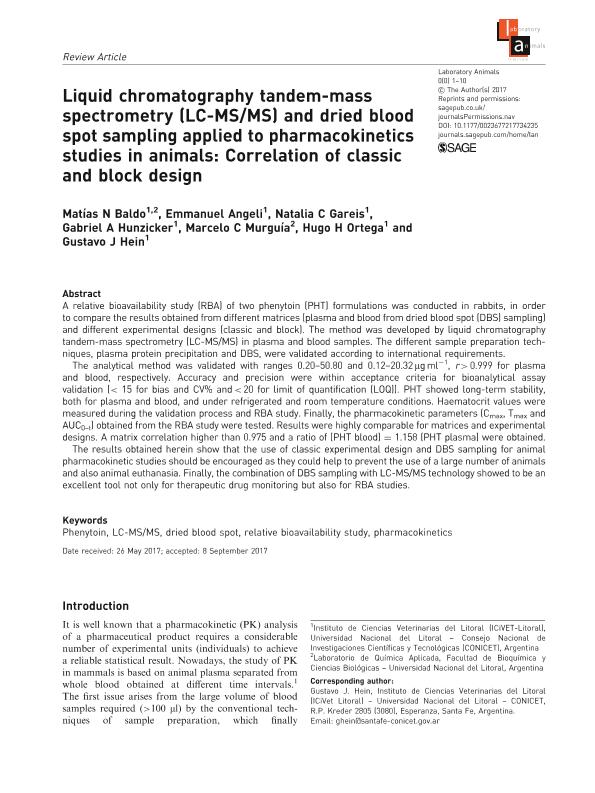Mostrar el registro sencillo del ítem
dc.contributor.author
Baldo, Matias Nicolas

dc.contributor.author
Angeli, Emmanuel

dc.contributor.author
Gareis, Natalia Carolina

dc.contributor.author
Hunzicker, Gabriel Alejandro

dc.contributor.author
Murguia, Marcelo Cesar

dc.contributor.author
Ortega, Hugo Hector

dc.contributor.author
Hein, Gustavo Juan

dc.date.available
2018-04-12T16:59:15Z
dc.date.issued
2017-10
dc.identifier.citation
Baldo, Matias Nicolas; Angeli, Emmanuel; Gareis, Natalia Carolina; Hunzicker, Gabriel Alejandro; Murguia, Marcelo Cesar; et al.; Liquid chromatography tandem-mass spectrometry (LC-MS/MS) and dried blood spot sampling applied to pharmacokinetics studies in animals: Correlation of classic and block design; Royal Soc Medicine Press Ltd; Laboratory Animals; 52; 2; 10-2017; 125-134
dc.identifier.issn
0023-6772
dc.identifier.uri
http://hdl.handle.net/11336/41851
dc.description.abstract
A relative bioavailability study (RBA) of two phenytoin (PHT) formulations was conducted in rabbits, in order to compare the results obtained from different matrices (plasma and blood from dried blood spot (DBS) sampling) and different experimental designs (classic and block). The method was developed by liquid chromatography tandem-mass spectrometry (LC-MS/MS) in plasma and blood samples. The different sample preparation techniques, plasma protein precipitation and DBS, were validated according to international requirements. The analytical method was validated with ranges 0.20–50.80 and 0.12–20.32 mg ml1 , r> 0.999 for plasma and blood, respectively. Accuracy and precision were within acceptance criteria for bioanalytical assay validation (< 15 for bias and CV% and< 20 for limit of quantification (LOQ)). PHT showed long-term stability, both for plasma and blood, and under refrigerated and room temperature conditions. Haematocrit values were measured during the validation process and RBA study. Finally, the pharmacokinetic parameters (Cmax, Tmax and AUC0–t) obtained from the RBA study were tested. Results were highly comparable for matrices and experimental designs. A matrix correlation higher than 0.975 and a ratio of (PHT blood) ¼ 1.158 (PHT plasma) were obtained. The results obtained herein show that the use of classic experimental design and DBS sampling for animal pharmacokinetic studies should be encouraged as they could help to prevent the use of a large number of animals and also animal euthanasia. Finally, the combination of DBS sampling with LC-MS/MS technology showed to be an excellent tool not only for therapeutic drug monitoring but also for RBA studies.
dc.format
application/pdf
dc.language.iso
eng
dc.publisher
Royal Soc Medicine Press Ltd

dc.rights
info:eu-repo/semantics/openAccess
dc.rights.uri
https://creativecommons.org/licenses/by-nc-sa/2.5/ar/
dc.subject
Phenytoin
dc.subject
Lc-Ms/Ms
dc.subject
Dried Blood Spot
dc.subject
Relative Vioavailability Study
dc.subject
Pharmacokinetics
dc.subject.classification
Zoología, Ornitología, Entomología, Etología

dc.subject.classification
Ciencias Biológicas

dc.subject.classification
CIENCIAS NATURALES Y EXACTAS

dc.title
Liquid chromatography tandem-mass spectrometry (LC-MS/MS) and dried blood spot sampling applied to pharmacokinetics studies in animals: Correlation of classic and block design
dc.type
info:eu-repo/semantics/article
dc.type
info:ar-repo/semantics/artículo
dc.type
info:eu-repo/semantics/publishedVersion
dc.date.updated
2018-04-05T18:39:21Z
dc.journal.volume
52
dc.journal.number
2
dc.journal.pagination
125-134
dc.journal.pais
Reino Unido

dc.journal.ciudad
Londres
dc.description.fil
Fil: Baldo, Matias Nicolas. Consejo Nacional de Investigaciones Científicas y Técnicas. Centro Científico Tecnológico Conicet - Santa Fe. Instituto de Ciencias Veterinarias del Litoral. Universidad Nacional del Litoral. Facultad de Ciencias Veterinarias. Instituto de Ciencias Veterinarias del Litoral; Argentina
dc.description.fil
Fil: Angeli, Emmanuel. Consejo Nacional de Investigaciones Científicas y Técnicas. Centro Científico Tecnológico Conicet - Santa Fe. Instituto de Ciencias Veterinarias del Litoral. Universidad Nacional del Litoral. Facultad de Ciencias Veterinarias. Instituto de Ciencias Veterinarias del Litoral; Argentina
dc.description.fil
Fil: Gareis, Natalia Carolina. Consejo Nacional de Investigaciones Científicas y Técnicas. Centro Científico Tecnológico Conicet - Santa Fe. Instituto de Ciencias Veterinarias del Litoral. Universidad Nacional del Litoral. Facultad de Ciencias Veterinarias. Instituto de Ciencias Veterinarias del Litoral; Argentina
dc.description.fil
Fil: Hunzicker, Gabriel Alejandro. Consejo Nacional de Investigaciones Científicas y Técnicas. Centro Científico Tecnológico Conicet - Santa Fe. Instituto de Ciencias Veterinarias del Litoral. Universidad Nacional del Litoral. Facultad de Ciencias Veterinarias. Instituto de Ciencias Veterinarias del Litoral; Argentina
dc.description.fil
Fil: Murguia, Marcelo Cesar. Universidad Nacional del Litoral. Facultad de Bioquímica y Ciencias Biológicas; Argentina
dc.description.fil
Fil: Ortega, Hugo Hector. Consejo Nacional de Investigaciones Científicas y Técnicas. Centro Científico Tecnológico Conicet - Santa Fe. Instituto de Ciencias Veterinarias del Litoral. Universidad Nacional del Litoral. Facultad de Ciencias Veterinarias. Instituto de Ciencias Veterinarias del Litoral; Argentina
dc.description.fil
Fil: Hein, Gustavo Juan. Consejo Nacional de Investigaciones Científicas y Técnicas. Centro Científico Tecnológico Conicet - Santa Fe. Instituto de Ciencias Veterinarias del Litoral. Universidad Nacional del Litoral. Facultad de Ciencias Veterinarias. Instituto de Ciencias Veterinarias del Litoral; Argentina
dc.journal.title
Laboratory Animals

dc.relation.alternativeid
info:eu-repo/semantics/altIdentifier/url/http://journals.sagepub.com/doi/10.1177/0023677217734235
dc.relation.alternativeid
info:eu-repo/semantics/altIdentifier/doi/http://dx.doi.org/10.1177/0023677217734235
Archivos asociados
